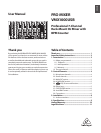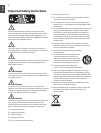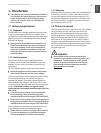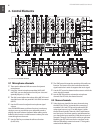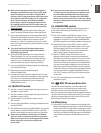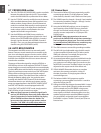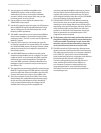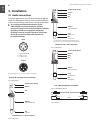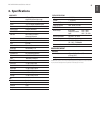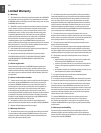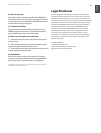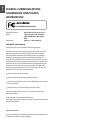
ENGLISH
PRO MIXER VMX1000USB User Manual
6
ENGLISH
PRO MIXER VMX1000USB User Manual
7
CROSSfADER 2.7 section
The [28] VcA cONtrOLLED crOSSFADEr is used to cross fade
between the selected channels (see
{ 30 }). The crossfader
used in the VMX1000USB is a professional 45-mm fader.
Use the
[29] cF cUrVE control to modify the control character
of the crossfader between linear and logarythmic in an
infinite number of steps. When in linear characteristic
mode, the crossfader fades equally in each segment of
its movement range; in the logarythmic characteristic
mode, volume control is concentrated to the outer
segment of the fader’s range of motion.
Use the
[30] ASSIGN A and ASSIGN B rotary switches to
determine which input signals are routed to the A and
B sides of the CROSSFADER. With ASSIGN A, channels 1
through 4 can be selected; with ASSIGN B, channels 2
through 5. Then, you can alternate between these two
channels using the CROSSFADER (see
{ 28 }).
AUTO BPM COUNTER2.8
The integrated auto BPM counter is an extremely useful
feature. It ensures smooth transition from one track to the
next. It can calculate the tempos of various tracks in BPM
(beats per minute). Both BPM counter sections are identical
and both show the BPM value of the two stereo channels
routed to the crossfader.
The tempo of the track assigned by using the ASSIGN A or
ASSIGN B keys is shown in the respective DISPLAY
{ 31 }. Several
tempo changes in one track would produce a constant display
of various BPM values and thus lead to unnecessary confusion.
That’s why each beat counter section has a SYNc LOcK button
{ 32 } that can be used during the song to limit the range of
possible tempo values. This makes sense if the counter has
already calculated a realistic value. You can do the same
manually with the BEAt ASSISt button
{ 33 }. Push this button
at least three times in sync with the song’s tempo, and the
tempo you tapped appears in the DISPLAY. The BEAT ASSIST
and SYNC LOCK buttons are each equipped with a LED.
To exit SYNC LOCK or BEAT ASSIST mode, simply press the
SYNC LOCK key in both channels once again.
When no signal is present (or when the signal level is
◊
too low), the BPM display shows only dashes. When the
signal is present but can not be identified, the display
shows 160 BPM and then shows the dashes. The
beat counter then attempts to get another readout.
Therefore, “160” BPM is no usable value; rather, it is
simply an error message when the signal can not
be analyzed.
Connections2.9
These are the [34] LINE and cD inputs respectively, used for
connecting tape decks, CD or MD players etc. Unlike
other channels, channels 4 and 5 feature two line inputs.
The
[35] PHONO inputs for channels 1 through 3 are intended
for connecting turntables. Channels 1 through 3 can be
switched over to line level (see
{ 36 }).
Using the
[36] PHONO/LINE switches, you can change the
input sensitivity of the PHONO inputs on channels 1
through 3 to line level (switch pressed). This way, you
can even connect a tape deck or a CD player to the
PHONO inputs.
IMPORTANT: Always pay attention to the correct
◊
position of the PHONO/LINE switch when connecting a
line level signal to a phono input. The switch must be in
its pressed position (LINE)! Otherwise, overdriving may
lead to permanent damage to the phono input.
The
[37] GND connectors are used for grounding turntables.
The MIC AUX signal, adjustable using the AUX controls
[38]
on the microphone channels (see { 3 }), is laid out at this
SEND jack connector. For example, the input of an
external reverb can be connected here.
An external stereo effects signal can be fed back into the
[39]
VMX1000USB using the rEtUrN L/r jack connectors. If
you connect a mono effects signal, you need to use the
left RETURN L connector. The effect volume can only be
adjusted on the output control of the effects unit.
SErIAL NUMBEr
[40] . Please take the time to complete
and return the warranty card within 14 days of
the date of purchase. Or, simply register online at
www.behringer.com.
The balanced
[41] MAIN 1 XLR outputs are used for
connecting a power amplifier. Use the VOL 1 control to
adjust the volume (see
{ 16 }).
Hitting the
[42] MONO key changes the stereo MAIN 1 output
signal into a mono signal. Doing this makes sense when
you for example use your PRO MIXER in large rooms
where the speakers are placed far from each other. A
stereo signal would have a disrupting effect, since the
speakers each transmit a somewhat different signal. If
you press MONO, an identical signal is transmitted to
both MAIN 1 outputs. The BAL 1 control (see
{ 18 }) has no
function here.
You can connect an additional amplifier to the [43]
SUBWOOFEr output in order to drive a passive
subwoofer. If you wish to use an active subwoofer,
connect it directly to this output. Either way, you get
more bass power out of your music.
Use the
[44] LEVEL control to adjust the volume of the
SUBWOOFER output signal.
Use the
[45] X/O control to adjust the upper cut-off frequency
of the SUBWOOFER signal (adjustable between 30 and
200 Hz). All frequencies with values below the cut-off
frequency will be reproduced.
The
[46] MAIN 2 output allows you to connect an amplifier to
drive monitor speakers or to provide sound in another
room/area (“zone”). The VOL 2 control (see
{ 17 }) adjusts the
MAIN OUT section.
Using the
[47] tAPE output, you can record your music by
connecting equipment such as tape decks, DAT recorders
etc. Unlike the MAIN outputs, the output volume is fixed,
making it necessary for you to adjust the input level on
the recording device.
Your PRO MIXER features an effects loop that can be
[48]
used for an external effects unit or a sampler. The signal
is taken at the PFL section through the SEND connector
and fed into your external equipment. The signal laid
out at the SEND connector is therefore identical to the
headphone signal. Connect this output to the input of
your effects unit.
The signal that was processed externally is mixed into the
[49]
MAIN OUT signal using the rEtUrN channel. Use the RET
control to adjust the volume of the effects signal (see
{ 27 }).
Connect this input to the outputs of your effects unit.
This is the connector for the power cable. This is where
[50]
the advantage of a sophisticated internal power supply
can be seen: the pulse behaviour of each amplifying
circuit is mainly determined by the voltage reserves
available. Each mixing console is equipped with
numerous operational amplifiers (op amps) to process
line level signals. Due to limited output of their power
supplies, many mixing consoles show signs of “stress”
when subjected to heavy loads. But not your PRO MIXER:
the sound is always clear and transparent.
FUSE HOLDEr / VOLtAGE SEttING
[51] . Before connecting
the unit to the mains, ensure that the voltage setting
matches your local voltage. Blown fuses should only be
replaced by a fuse of the same type and rating. On some
units, the fuses holder can be switched to one of two
positions, i.e. 230 V and 120 V. Please note: should you
desire to operate the unit outside Europe at 120 V,
a higher fuse rating is required.
To disconnect power from main, pull out the main cord
◊
plug. When installing the product, ensure that the plug
is easily accessible. If mounting in a rack, ensure that
the mains can be easily disconnected by a plug or by
an all-pole disconnect switch on or near the rack.
The VMX has built-in USB connectivity, allowing stereo
[52]
signals to be sent to and from the mixer and a computer.
The audio sent from the mixer to a computer is identical
to the TAPE OUT signal, which is the pre-fader MAIN
signal. Audio being sent from a computer to the VMX can
be selected with the Channel 1 INPUT button.
Connect a USB type B plug into the USB jack on the
mixer, and the other end into a free USB port on
your computer. There are no required drivers, but
we recommend that PC users install the included
ASIO driver. The driver can also be downloaded from
www.behringer.com.



